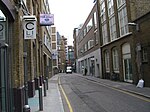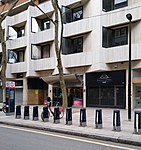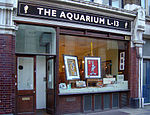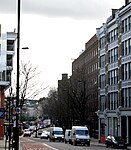Hatton Garden is a street and commercial zone in the Holborn district of the London Borough of Camden, abutting the narrow precinct of Saffron Hill which then abuts the City of London. It takes its name from Sir Christopher Hatton, a favourite of Queen Elizabeth I, who established a mansion here and gained possession of the garden and orchard of Ely Place, the London seat of the Bishops of Ely. It remained in the Hatton family and was built up as a stylish residential development in the reign of King Charles II. For some decades it often went, outside of the main street, by alternative name St Alban's Holborn, after the local church built in 1861.
St Etheldreda's Church in Ely Place, all that survives of the old Bishop's Palace, is one of only two remaining buildings in London dating from the reign of Edward I. It is one of the oldest churches in England now in use for Roman Catholic worship, which was re-established there in 1879. The red-brick building now known as Wren House, at the south-east corner of Hatton Garden and St Cross Street, was the Anglican church for the Hatton Garden development. It was taken over by the authorities of a charity school, and the statues of a boy and girl in uniform were then added.
Hatton Garden is famous as London's jewellery quarter and the centre of diamond trade in the United Kingdom. This specialisation grew up in the early 19th century, spreading out from its more ancient centre in nearby Clerkenwell. Today there are nearly 300 businesses here in the jewellery industry and over 55 shops, representing the largest cluster of jewellery retailers in the UK. The largest of these businesses was De Beers, the international family of companies which dominated the international diamond trade. Their headquarters were in an office and warehouse complex just behind the main Hatton Garden shopping street.
Sir Hiram Maxim had a small factory at 57 Hatton Garden and in 1881, invented and started to produce the Maxim Gun, a prototype machine gun, capable of firing 666 rounds a minute. Hatton Garden has an extensive underground infrastructure of vaults, tunnels, offices and workshops. The area is now home to many media, publishing and creative businesses, including Blinkbox and Grey Advertising. Surrounding streets including Hatton Place and Saffron Hill (the insalubrious setting for Fagin's den in Oliver Twist) were improved during the 20th century and in modern times have been developed with blocks of 'luxury' apartments, including Da Vinci House (occupying the former Punch magazine printworks) and the architecturally distinctive Ziggurat Building.











